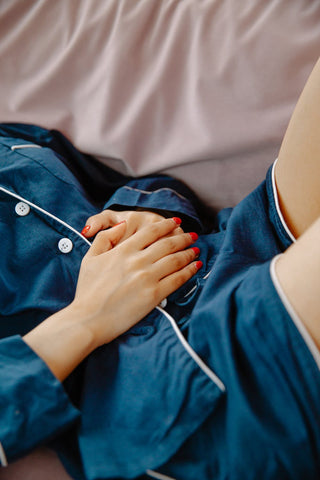Although many expectant parents envision a vaginal delivery, the reality is that approximately one-third of deliveries end in cesarean section. Having a cesarean section is nothing to be ashamed of: what is truly important is the health and well-being of both the parents and the baby. However, it is also essential to know that a c-section birth has a significant impact on the body and requires a careful approach to recovery.
C-sections are larger abdominal surgeries and many times the recovery process can be more intense and prolonged than that of vaginal deliveries. However, if you know what to expect during C-section birth recovery, you can move through this period with less stress.
In this blog post, we will explore some key aspects of cesarean birth recovery, providing valuable information to help parents prepare for and effectively manage the post-operative period.
|
TABLE OF CONTENT Recovering From Post-Surgery Pain: Making Yourself Comfortable after a C-Section Wound Healing: Taking Care of Your Incision |
Recovering From Post-Surgery Pain: Making Yourself Comfortable after a C-Section
After your cesarean section, it's normal to feel different levels of pain as your body heals from the big surgery. Here's what you need to know to deal with discomfort during your C-section birth recovery:
1. Post-surgery pain- Feeling pain after your surgery is totally normal. This pain can be mild or pretty intense, depending on stuff like how much pain you can handle and how complicated your surgery was.
- The cut they made during your cesarean section, plus the muscles and tissues around it, might feel sore and tender for a while. Plus, you might feel some cramps as your uterus gets back to its regular size.
- Your doctor will probably give you some pain medicine to help you deal with the pain after surgery. It's super important that you take these meds just like your doctor tells you, even if you're only feeling a little uncomfortable. They'll help keep the pain from getting worse.
Other ways to ease the pain
- Besides medicine, there are some other things you can try to help with the pain after your cesarean section. These can include:
- Putting ice packs or something cold on the spot where they cut you to help with swelling and numb the pain.
- Using something warm, like taking warm baths or using heating pads, to relax your sore muscles and feel more comfy.
-
Doing some deep breathing exercises, trying out mindfulness meditation, joining a Healing Circle focused on recovery, or using your imagination to take your mind off the pain and chill out.

- Open and honest communication with your healthcare provider is essential throughout the c-section birth recovery process. If you're feeling a lot of pain, or if it's getting worse even with the medicine, it's important to get in touch with them ASAP.
- Your doctor can change up your pain medicine or give you other support to help you handle the pain better.
Don't sweat it if you're feeling some pain after your cesarean section— it's totally normal! Just follow your doctor's advice on pain meds, try out some other ways to ease the pain, and keep in touch with your healthcare team. You'll be feeling better and bouncing back in no time!
How To Take Care of Your Incision
It's super important to keep it clean and healthy so you can heal up properly. Here's what you need to know:
4. Keeping it Clean
Your incision site needs to stay clean and dry to prevent infection. You'll want to gently wash it with mild soap and water and pat it dry with a clean towel. Avoid using harsh cleansers or scrubbing too hard, because that can irritate your skin.
5. Using Wonder SprayWonder Spray is a revolutionary product that can be sprayed on the perineal area to help heal the stitches and alleviate pain. Our Wonder Spray only offers a cooling, refreshing sensation after every spray.
6. Changing DressingsYour doctor will probably give you some dressings to cover your incision. You'll need to change these regularly to keep the area clean and dry.
7. Watching for Signs of InfectionIt's important to keep an eye out for any signs that your incision might be getting infected. If you notice any redness, swelling, warmth, or drainage from the incision site, or if you start running a fever, be sure to call your doc ASAP.
8. Taking it EasyWhile you're recovering from your C-section, it's important to take it easy and avoid putting too much strain on your incision site. Try to avoid lifting anything heavy or doing any strenuous activities until your doctor gives you the all-clear.
9. Follow-up CareAfter you're discharged from the hospital, you'll probably have a follow-up appointment with your doctor to check on how you're healing. Be sure to go to this appointment and follow any instructions your doctor gives you for continued care.
Managing Anesthesia Side Effects
Dealing with nausea after your C-section birth recovery can be a bit of a challenge, thanks to the anesthesia used during the surgery. Here are some tips to help you manage this common side effect:
10. Stay HydratedDrinking plenty of fluids is key. Water, clear broths, and herbal teas can help keep you hydrated and might ease that queasy feeling. Sipping slowly throughout the day is a good strategy to avoid overwhelming your stomach.
11. Eat Small, Frequent MealsInstead of having three large meals, try eating smaller, more frequent meals. Light snacks like crackers, toast, or plain rice can be easier on your stomach and help keep nausea at bay. Avoid greasy, spicy, or overly sweet foods as they can make nausea worse.
12. Try GingerGinger is known for its anti-nausea properties. You can try ginger tea, ginger ale (make sure it's the real ginger kind), or ginger candies. Sometimes, a bit of natural remedy can go a long way.
13. Take Prescribed MedicationsYour doctor may prescribe medications to help manage nausea. It's important to take these exactly as directed. Don't hesitate to ask your healthcare provider if you're unsure about the medication or if you're experiencing any side effects.
14. Rest and RelaxMake sure you get plenty of rest. Stress and fatigue can make nausea worse, so try to relax as much as possible. Sometimes, just lying down in a quiet, dark room can help you feel better. Listening to calming music or practicing deep breathing exercises can also be beneficial.

Seeking Support: Building a Recovery Network
Recovering from a C-section can be a bit overwhelming, and having a solid support system is essential. Here’s how you can build a recovery network to help you through this period:
15. Enlist Family and FriendsDon’t hesitate to ask your family and friends for help. Whether it’s running errands, helping with household chores, or providing emotional support, your loved ones are often more than willing to pitch in. Let them know specifically what you need—people are usually happy to help when they know how.
16. Consider Professional HelpSometimes, professional assistance can make a big difference. Postpartum doulas, babysitters, or cleaning services can ease the load and allow you to focus on healing. If your budget allows, hiring some extra help can be a real game-changer.
17. Join Support GroupsJoining a support group, either in-person or online (Facebook groups are a good option), can provide you with a community of people who understand what you’re going through. Sharing experiences and tips with others who have had C-sections can be incredibly reassuring and helpful.
18. Utilize Community ResourcesCheck out local community resources that might be available to you. Many hospitals and community centers offer postpartum support programs, lactation consulting, and parenting classes. These resources can provide valuable information and support during your c-section birth recovery.
19. Communicate with Your PartnerOpen communication with your partner is key. Make sure they understand what you’re going through and what kind of support you need. Whether it’s taking on more household duties or just being there to listen, a supportive partner can make a huge difference in your recovery journey.

The key is to give yourself grace and time to heal. Recovery might be slower than you’d like, but each day gets you closer to feeling better. You’ve been through major surgery to bring your baby into the world, and that’s huge. Take pride in your strength, lean on your support system, and remember it’s okay to ask for help. With patience and the right care, you’ll get through this recovery period and be back to enjoying precious moments with your new baby.






